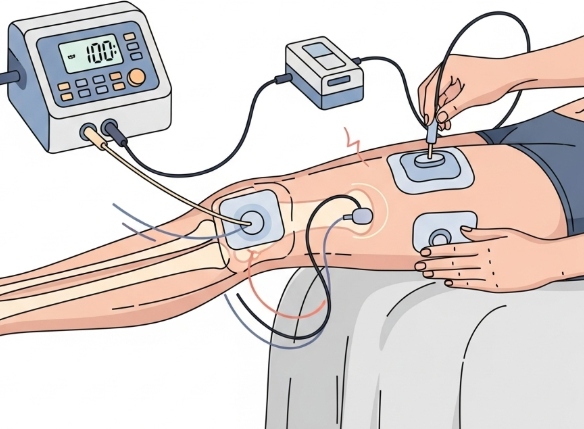Are you tired of that nagging ache on the outside of your knee? Does it limit your runs, hinder your hikes, or make
everyday activities a struggle? If so, you're not alone. Many individuals experience the frustrating pain of Iliotibial
Band Syndrome (ITBS), a condition that can significantly impact your daily life and athletic performance. This blog
explores how Interferential Therapy (IFT), a non-invasive physiotherapy treatment, could provide long-term relief
from chronic IT band pain. We'll delve into what ITBS is, how IFT works, and the potential benefits it offers, all
while staying firmly within the scope of physiotherapy practice. Let's embark on a journey to understand how IFT
can be a game changer in your IT band pain recovery. Remember, seeking professional help is crucial for proper
diagnosis and personalized treatment.
IT Band Syndrome (ITBS): Understanding the Source of Your Pain
IT Band Syndrome (ITBS) is a common overuse injury, often causing pain on the outer side of the knee. The
iliotibial (IT) band, a thick band of tissue extending from your hip down to your knee, becomes inflamed, leading to
this discomfort. This inflammation frequently arises from repetitive movements, poor biomechanics, or inadequate
stretching. For instance, overpronation, leg length discrepancies, or muscle imbalances can contribute to ITBS.
Activities like running, cycling, and even prolonged sitting can trigger the pain. Patient education and treatment
adherence are crucial. Running at faster paces and on a flat ground have been shown to limit the time in
the so-called "impingement zone” between the lateral femoral epicondyle and ITB. Furthermore, patients must
change their shoes regularly to prevent uneven wear of the soles.
Patients may also benefit from a physical therapist to improve their sport-specific biomechanics. It is crucial that the patient
is aware that the ITBS can sometimes relapse after returning to activities, and they should restart the nonoperative
treatment progression.
Interferential Therapy (IFT): A Gentle Approach to Pain Relief
Interferential Therapy (IFT) is a cutting-edge electrotherapy technique that is revolutionizing physiotherapy by
offering deep pain relief and accelerating healing. It involves the application of two different frequencies of
electrical current that intersect deep within the body's tissues. This intersection creates a resultant therapeutic
current that stimulates the body's natural healing mechanisms. The physiological mechanisms behind IFT involve
stimulating the release of endorphins, the body's natural painkillers, increasing blood flow to the affected area,
and reducing muscle spasms. During IFT, patients may experience a gentle tingling or pulsing sensation. Unlike
some other electrotherapy modalities, IFT is known for its ability to penetrate deeper into tissues, targeting the
source of pain more effectively. The gentle electrical stimulation can help reduce inflammation, decrease muscle
spasms, and promote the release of endorphins, the body's natural painkillers.
IFT for Chronic ITBS: Breaking the Pain Cycle
IFT can be a powerful tool in managing chronic IT band pain by directly addressing the root causes of the
condition. By reducing pain and inflammation, IFT can help break the cycle of pain and muscle spasm that
often accompanies ITBS. This allows for more effective participation in other physiotherapy interventions, such
as stretching and strengthening exercises. Reduced pain allows for more effective stretching and strengthening
exercises. The increased blood flow promoted by IFT can also aid in tissue healing and reduce muscle tightness.
By targeting the deeper tissues around the IT band, IFT can help restore normal function and reduce the risk of
recurrence. Combining IFT with IT band pain exercises and other physiotherapy techniques can lead to significant
improvements in pain levels and overall function.
Long-Term Outcomes: What to Expect
The secret to lasting relief lies in a personalized treatment plan that targets the unique underlying causes of your
IT band pain. While individual results may vary, many patients experience significant and lasting relief from IT band
pain with IFT. The timeline for recovery can vary, but with consistent adherence to the treatment plan and lifestyle
modifications, long-term relief is achievable. This may include adjusting training schedules, modifying footwear,
or incorporating regular stretching into daily routines. Maintaining a healthy weight and avoiding activities that
exacerbate IT band pain are also important. IFT can play a crucial role in this process by providing pain relief and
promoting tissue healing, allowing patients to actively participate in their rehabilitation. Consistent adherence to
the treatment plan and lifestyle modifications are essential for preventing recurrence and maintaining long-term
pain relief.
Conclusion
Chronic IT band pain can be a debilitating condition, but it doesn't have to control your life. Interferential
Therapy offers a promising, non-invasive approach to pain relief and tissue healing. By reducing pain, decreasing
inflammation, and promoting healing, IFT can help you break free from the pain cycle and reclaim your active
lifestyle. If you're struggling with persistent IT band pain, we invite you to connect with a skilled physiotherapist
for a precise diagnosis and a treatment plan designed just for you. Let us help personalize your physiotherapy
experience. Have you tried IFT for IT Band pain? Share your experiences in the comments below! #ITBandPain
#PhysicalTherapy #InterferentialTherapy #KneePain #SportsMedicine #InjuryRecovery.
